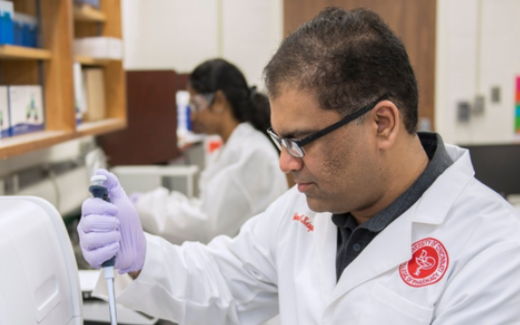America
Indian-origin researcher leads study of imaging technology to diagnose lung infections

New York, Aug 16
A study led by an Indian-origin researcher of University of Cincinnati looks to develop a new imaging technique that can identify certain types of lung infections in order to speed up treatment for critically ill patients.
According to Nalinikanth Kotagiri, an associate professor of pharmaceutical sciences at the UC James L. Winkle College of Pharmacy, imaging has the potential to identify specific lung infections in real time -- instead of taking two to three days.
Kotagiri and his team will develop and study the effectiveness of different kinds of injectable probes (metallic contrast agents) that would collect at the site of the infection and immediately light up under a nuclear imaging machine, known as a PET scan.
Currently, radiologists use chest X-rays to confirm the diagnosis of pneumonia and other infections in the lungs, which cannot determine the specifics of the infection or whether the infection is bacterial, viral or fungal.
A specific diagnosis can only be determined by a pathologist, after culturing a sample of lung tissue which is collected from an invasive procedure (called a bronchoscopy) and takes time, typically two-three days.
Critically ill patients, however, such as those with infectious pneumonia and underlying conditions such as chronic obstructive pulmonary disease (COPD), might not have time to spare, says Kotagiri.
"Our solution is to use imaging to identify what is causing the pneumatic episode," within hours, to hasten a treatment plan, he says.
An added benefit, says Kotagiri, is that the contrast agent development process "doesn’t require elaborate processing or preparation timeâ€.
This is critical as development of contrast agents can be time-consuming and complicated. A simple and fast process is expected to reduce preparation time in a clinical laboratory and potentially enable adoption of the technology in a clinical setting.
With this study in animal models, Kotagiri and team will only be looking at bacterial and viral pneumonias in conjunction with COPD, but the imaging approach has the potential to apply to other types of infections such as fungal infections or conditions such as cystic fibrosis.
According to Kotagiri, imaging the patient after treatment could also identify whether the patient is responding to medications such as antibiotics.
Imaging could also potentially aid in determining the right antibiotics to use, targeting the pathogens that were identified, he said.
For the study, Kotagiri has been awarded a five-year $3 million, R01 grant from the National Heart, Lung, and Blood Institute (NHLBI). The R01, or Research Project Grant, provides support for health-related research and development based on the mission of the National Institutes of Health.

5 minutes ago
Brad Pitt has plans for a simple Thanksgiving

6 minutes ago
Mammootty-starrer 'Kalamkaval' to now hit screens on December 5

7 minutes ago
Karan Johar attends the London leg of 'Homebound' screening hosted by Gurinder Chadha

8 minutes ago
Priyanka Chopra marks her homecoming with an adorable selfie

8 minutes ago
Tiger Shroff calls it an ‘honour’ to perform for soldiers and their families

9 minutes ago
Nicole Kidman loves that one ‘break’ can change course of anyone's life

9 minutes ago
Soha Ali Khan urges urgent action as AQI touches severe levels: We are breathing in toxic fumes

12 minutes ago
Kriti Sanon shares a candid moment of filmmaker Aanand L. Rai calmly sleeping on a flight

13 minutes ago
First single 'Gira Gira Gingiraagirey' from Pradeep Advaitham's sports drama 'Champion' is a mellifluous delight

16 minutes ago
Kareena Kapoor calls BFF Natasha Poonawalla ‘queen’ in sweet birthday shout-out

22 minutes ago
Kejriwal hails ‘politics done with honesty’ as AAP marks Foundation Day

24 minutes ago
Facing restrictions in Tamil Nadu, Vijay plans December 5 roadshow in Puducherry

27 minutes ago
Rana plays cat-and-mouse game: Extradited 26/11 accused dodges investigators with ISI-honed tactics






















